You can sometimes prove a statement by:
1. Dividing the situation into cases which exhaust all the possibilities; and
2. Showing that the statement follows in all cases.
It's important to cover all the possibilities. And don't confuse this with trying examples; an example is not a proof.
Note that there are usually many ways to divide a situation into cases. For example, if I know that x is a real number and I'm proving something about x, here are some ways I could take cases:
(a) ![]() ,
, ![]() , or
, or ![]() .
.
(b) ![]() or
or ![]() .
.
(c) ![]() or
or ![]()
(d) x is rational or x is irrational.
There are an infinite number of ways to divide up the real numbers to take cases; how you do it depends on what you're trying to prove. In general, you should try to use a small number of cases --- and in particular, you should see if you can give a proof without taking cases at all!
I'll begin with a logic proof. In this situation, your cases are
usually P and ![]() , where P is a statement.
, where P is a statement.
Example. Premises: 
Prove: ![]() .
.
I can divide the situation into two cases: Either C is true, or ![]() is true. These exhaust the possibilities, by the Law
of the Excluded Middle. I'll assume each in turn and show that I can
derive
is true. These exhaust the possibilities, by the Law
of the Excluded Middle. I'll assume each in turn and show that I can
derive ![]() .
.
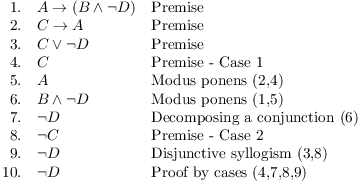
Since both of my cases led to the conclusion ![]() , and since my cases exhausted the possibilities,
I've proved
, and since my cases exhausted the possibilities,
I've proved ![]() .
.
In logic proofs, cases of the form P and ![]() where P is some statement will cover all
possibilities, since one of P or
where P is some statement will cover all
possibilities, since one of P or ![]() must be true. So
these are the natural cases to take in logic proofs.
must be true. So
these are the natural cases to take in logic proofs.
How did I know to use C and ![]() rather than (say)
B and
rather than (say)
B and ![]() ? I looked at my premises and noticed that
I could do something with each of those assumptions: C could be used
for modus ponens, and
? I looked at my premises and noticed that
I could do something with each of those assumptions: C could be used
for modus ponens, and ![]() could be used for disjunctive
syllogism. As with many logic proofs, it was a matter of looking
ahead or working backward.
could be used for disjunctive
syllogism. As with many logic proofs, it was a matter of looking
ahead or working backward.
Note: You may use the premises for the proof in either case, but you may not use a statement derived for one case in the other case.
For example, in the first case, I derived the statement A at line 5.
I may not use A anywhere in the second case.![]()
Example. In calculus, you learned Rolle's theorem. Here's the statement:
Let f be a function which is continuous on the interval ![]() and is differentiable on the interval
and is differentiable on the interval ![]() . Suppose
. Suppose ![]() . Then there is a
real number c such that
. Then there is a
real number c such that ![]() and
and ![]() .
.
In other words (to put it roughly), between two roots there must be a horizontal tangent.
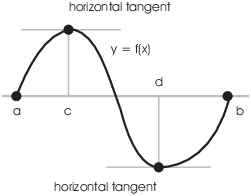
Prove Rolle's Theorem by taking cases.
There are three cases: f is never positive or negative on the
interval ![]() , f is positive somewhere on the
interval
, f is positive somewhere on the
interval ![]() , or f is negative somewhere on
the interval
, or f is negative somewhere on
the interval ![]() .
.
Suppose first that f is never positive or negative on the interval
![]() . Then
. Then ![]() , a constant
function, and
, a constant
function, and ![]() for all x in the interval
for all x in the interval ![]() .
.
Suppose that f is positive at some point of the interval ![]() . A continuous function on a closed interval attains
a maximum value on the interval; since I already know f is positive
somewhere, the maximum value of f must be positive. Since f
is 0 at the endpoints, it must attain the maximum value at some point
c in the open interval
. A continuous function on a closed interval attains
a maximum value on the interval; since I already know f is positive
somewhere, the maximum value of f must be positive. Since f
is 0 at the endpoints, it must attain the maximum value at some point
c in the open interval ![]() .
.
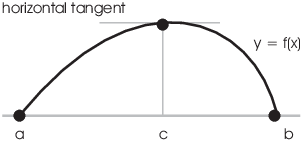
Since ![]() , f is differentiable at c. But at a point
where a differentiable function attains a maximum, the derivative is
0. Therefore,
, f is differentiable at c. But at a point
where a differentiable function attains a maximum, the derivative is
0. Therefore, ![]() .
.
Suppose that f is negative at some point of the interval ![]() . A continuous function on a closed interval attains
a minimum value on the interval; since I already know f is negative
somewhere, the minimum value of f must be negative. Since f
is 0 at the endpoints, it must attain the minimum value at some point
c in the open interval
. A continuous function on a closed interval attains
a minimum value on the interval; since I already know f is negative
somewhere, the minimum value of f must be negative. Since f
is 0 at the endpoints, it must attain the minimum value at some point
c in the open interval ![]() .
.
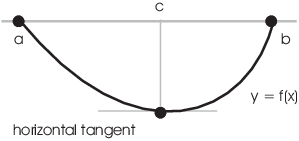
Since ![]() , f is differentiable at c. But at a point
where a differentiable function attains a minimum, the derivative is
0. Therefore,
, f is differentiable at c. But at a point
where a differentiable function attains a minimum, the derivative is
0. Therefore, ![]() .
.
Since the three cases exhaust all the possibilities, this proves that
![]() for some c in the interval
for some c in the interval ![]() .
.![]()
Many problems involving divisibility of integers use the Division Algorithm. It is a consequence of the Well-Ordering Axiom for the positive integers, which is also the basis for mathematical induction.
Theorem. (Division
Algorithm) Let m and n be integers, where ![]() . Then there are unique integers q and r such that
. Then there are unique integers q and r such that
![]()
("q" stands for "quotient" and "r" stands for "remainder".)
I won't give a proof of this, but here are some examples which show how it's used.
Example. Apply the Division Algorithm to:
(a) Divide 31 by 8.
(b) Divide -31 by 8.
(c) Divide an integer m by 2.
(a) Let ![]() and
and ![]() . Then I have
. Then I have
![]()
In this case, ![]() and
and ![]() . Note that
. Note that ![]() holds --- when you divide, the remainder should be
nonnegative, and less than the number you divided by.
holds --- when you divide, the remainder should be
nonnegative, and less than the number you divided by.![]()
(b) (a) Let ![]() and
and ![]() . Then I have
. Then I have
![]()
In this case, ![]() and
and ![]() . Again,
. Again, ![]() holds. Note that if I wrote "
holds. Note that if I wrote "![]() ", the equation is true, but
the numbers aren't the ones produced by the
Division Algorithm --- r is not allowed to be negative.
", the equation is true, but
the numbers aren't the ones produced by the
Division Algorithm --- r is not allowed to be negative.![]()
(c) Take m to be an integer, and let ![]() . Then
. Then
![]()
Now since r is an integer and ![]() , I must have
, I must have ![]() or
or ![]() . Thus, if
. Thus, if ![]() , then
, then
![]()
Of course, the first case occurs when m is even, and the second case
occurs when m is odd. If a problem involves odd or even integers,
you might consider taking cases in this way.![]()
A similar situation occurs when n is any positive integer. For
example, if ![]() and
and ![]() , then
, then
![]()
The condition ![]() means
means ![]() ,
, ![]() ,
, ![]() ,
, ![]() , or
, or ![]() . So if
. So if ![]() , the possibilities are
, the possibilities are
![]()
If a problem involves divisibility by 5 you might consider taking cases in this way.
(When I discuss modular arithmetic, there will be an easier way to deal with these cases.)
Example. Prove that if n is an integer, then
![]() is even.
is even.
Let ![]() . I'll consider two cases: n is even and n
is odd.
. I'll consider two cases: n is even and n
is odd.
Case 1. n is even.
Since n is even, I can write ![]() , where
, where ![]() . Then
. Then

Since ![]() is an integer,
is an integer, ![]() is even if n is even.
is even if n is even.
Case 2. n is odd.
Since n is odd, I can write ![]() , where
, where ![]() . Then
. Then
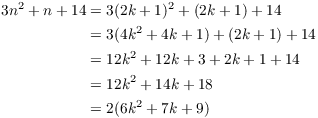
Since ![]() is an integer,
is an integer, ![]() is even if n is odd.
is even if n is odd.
Since in both cases ![]() is even, it follows that if n
is an integer, then
is even, it follows that if n
is an integer, then ![]() is even.
is even.![]()
Example. Prove that if n is an integer, then
![]() is not divisible by 3.
is not divisible by 3.
When n is divided by 3, the possible remainders are 0, 1, or 2. I consider these three cases.
Case 1. When n is divided by 3, the remainder is 0.
Then ![]() for some integer q. So
for some integer q. So

The last expression shows that in this case when ![]() is divided by 3, the remainder is 1. Hence,
is divided by 3, the remainder is 1. Hence, ![]() is not divisible by 3.
is not divisible by 3.
Case 2. When n is divided by 3, the remainder is 1.
Then ![]() for some integer q. So
for some integer q. So

The last expression shows that in this case when ![]() is divided by 3, the remainder is 1. Hence,
is divided by 3, the remainder is 1. Hence, ![]() is not divisible by 3.
is not divisible by 3.
Case 3. When n is divided by 3, the remainder is 2.
Then ![]() for some integer q. So
for some integer q. So

The last expression shows that in this case when ![]() is divided by 3, the remainder is 2. Hence,
is divided by 3, the remainder is 2. Hence, ![]() is not divisible by 3.
is not divisible by 3.
Since in every case ![]() is not divisible by 3, it
follows that
is not divisible by 3, it
follows that ![]() is not divisible by 3 for any
integer n.
is not divisible by 3 for any
integer n.![]()
Example. Prove that for all ![]() ,
,
![]()
You often think of taking cases in dealing with absolute values. I have
![]()
Now ![]() means
means ![]() , and
, and ![]() means
means ![]() . So
. So
![]()
In the same way,
![]()
Given the way the functions are broken apart, I'll consider the cases
![]() ,
, ![]() , and
, and ![]() . Notice that all real numbers are in one of the
three cases.
. Notice that all real numbers are in one of the
three cases.
Case 1. ![]() . In this case,
. In this case,
![]()
Therefore, ![]() holds in this case.
holds in this case.
Case 2. ![]() . In this
case,
. In this
case,
![]()
I have to do some additional work to see whether the target inequality holds. I have

Therefore, ![]() holds in this case.
holds in this case.
Case 3. ![]() . In this case,
. In this case,
![]()
Therefore, ![]() holds in this case.
holds in this case.
Since ![]() holds all three cases, it
is true for all
holds all three cases, it
is true for all ![]() .
.![]()
Copyright 2019 by Bruce Ikenaga